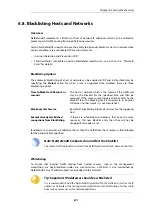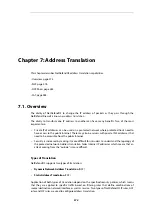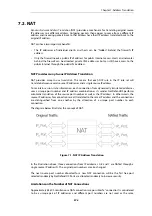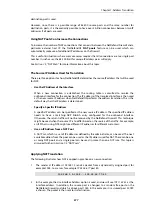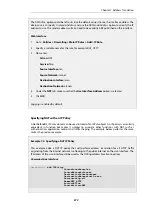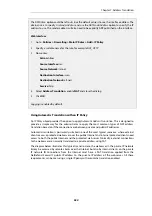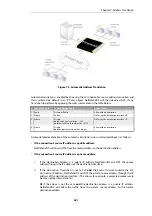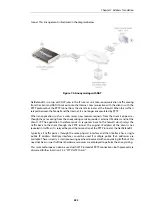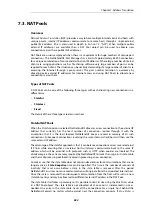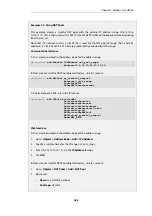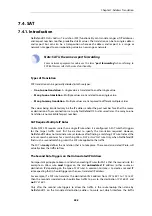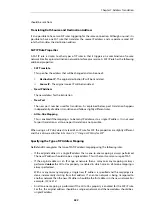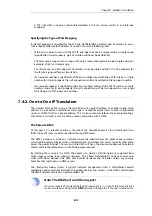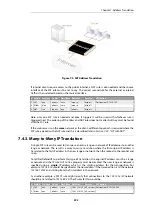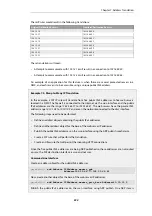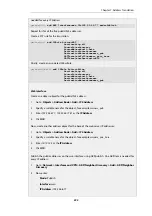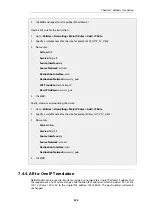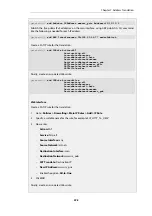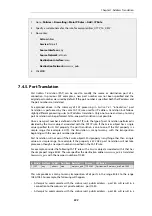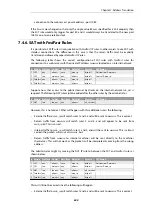
reached then an existing state with the longest idle time is replaced. If all states in the table is
active then the new connection is dropped. As a rule of thumb, the
Max States
value should be at
least the number of local hosts or clients that will connect to the Internet.
There is only one state table per NAT Pool so that if a single NAT Pool is reused in multiple NAT IP
rules they share the same state table.
Stateless NAT Pools
The
Stateless
option means that no state table is maintained and the external IP address chosen
for each new connection is the one that has the least connections already allocated to it. This
means two connections between one internal host to the same external host may use two
different external IP addresses.
The advantage of a Stateless NAT Pool is that there is good spreading of new connections
between external IP addresses with no requirement for memory allocated to a state table and
there is less processing time involved in setting up each new connection. The disadvantage is
that it is not suitable for communication that requires a constant external IP address.
Fixed NAT Pools
The
Fixed
option means that each internal client or host is allocated one of the external IP
addresses through a hashing algorithm. Although the administrator has no control over which of
the external connections will be used, this scheme ensures that a particular internal client or host
will always communicate through the same external IP address.
The Fixed option has the advantage of not requiring memory for a state table and providing very
fast processing for new connection establishment. Although explicit load balancing is not part of
this option, there should be spreading of the load across the external connections due to the
random nature of the allocating algorithm.
IP Pool Usage
When allocating external IP addresses to a NAT Pool it is not necessary to explicitly state these.
Instead a NetDefendOS
IP Pool
object can be selected. IP Pools gather collections of IP addresses
automatically through DHCP and can therefore supply external IP addresses automatically to a
NAT Pool. See
for more details about this topic.
Proxy ARP Usage
Where an external router sends ARP queries to the NetDefend Firewall to resolve external IP
addresses included in a NAT Pool, NetDefendOS will need to send the correct ARP replies for this
resolution to take place through its Proxy ARP mechanism so the external router can correctly
build its routing table.
By default, the administrator must specify in NAT Pool setup which interfaces will be used by NAT
pools. The option exists however to enable Proxy ARP for a NAT Pool on all interfaces but this can
cause problems sometimes by possibly creating routes to interfaces on which packets should not
arrive. It is therefore recommended that the interface(s) to be used for the NAT Pool Proxy ARP
mechanism are explicitly specified.
Using NAT Pools
NAT Pools are used in conjunction with a normal NAT IP rule. When defining a
NAT
rule, the
dialog includes the option to select a NAT Pool to use with the rule. This association brings the
NAT Pool into use.
Chapter 7: Address Translation
585
Summary of Contents for NetDefendOS
Page 30: ...Figure 1 3 Packet Flow Schematic Part III Chapter 1 NetDefendOS Overview 30 ...
Page 32: ...Chapter 1 NetDefendOS Overview 32 ...
Page 144: ...Chapter 2 Management and Maintenance 144 ...
Page 284: ...Chapter 3 Fundamentals 284 ...
Page 392: ...Chapter 4 Routing 392 ...
Page 419: ... Host 2001 DB8 1 MAC 00 90 12 13 14 15 5 Click OK Chapter 5 DHCP Services 419 ...
Page 420: ...Chapter 5 DHCP Services 420 ...
Page 573: ...Chapter 6 Security Mechanisms 573 ...
Page 607: ...Chapter 7 Address Translation 607 ...
Page 666: ...Chapter 8 User Authentication 666 ...
Page 775: ...Chapter 9 VPN 775 ...
Page 819: ...Chapter 10 Traffic Management 819 ...
Page 842: ...Chapter 11 High Availability 842 ...
Page 866: ...Default Enabled Chapter 13 Advanced Settings 866 ...
Page 879: ...Chapter 13 Advanced Settings 879 ...

